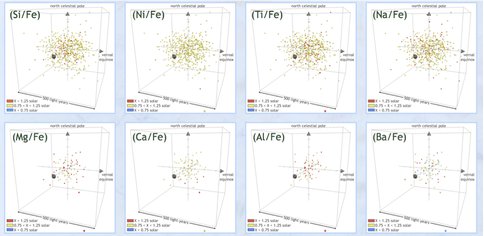2010 Annual Science Report
 Arizona State University
Reporting | SEP 2009 – AUG 2010
Arizona State University
Reporting | SEP 2009 – AUG 2010
Astrophysical Controls on the Elements of Life, Task 7: Update Catalog of Elemental Ratios in Nearby Stars
Project Summary
We are creating the first 3D maps of the elements for stars within 1000 light-years of the Sun, building upon the Habitable Star Catalog produced by Maggie Turnbull and Jill Tarter in 2003. We currently have abundance levels of bioessential elements for about 800 of the 17,000 stars listed in the Habitable Star Catalog. This project employs 2 graduate students (resulting in 1 PhD and 1 masters degree) and 1 undergraduate student. When this project is completed, our publicly available 3D maps will enable discovery of directions, or regions, in space where stars have abundance patterns more favorable to producing habitable worlds.
Project Progress
We are creating the first 3D maps of the elements for stars within 1000 light-years of the Sun, building upon the Habitable Star Catalog (HabCat) produced by Maggie Turnbull and Jill Tarter in 2003. A large fraction of our work this past year involved meticulously combing through spectroscopic stellar abundance determinations published within the past 30 years. Another large fraction of our efforts involved developing software tools to determine if our painstaking data mining efforts result in matches with stars in the HabCat. If there is a match, the new tools will automatically produce a listing that is easy to search for deterministic trends. We currently have determined bioessential element abundances for about 800 of the 17,000 stars listed in the Habitable Star Catalog (see Figure 1).
This project employed 2 graduate students and 1 undergraduate student, over the reporting period, andwill result in 1 PhD, 1 Masters, and 1 Bachelors degree by January 2012. We anticipate publishing 3 papers in the Astrophysical Journal over the next 2 years describing the results of this project and their implications. When this project is completed, our publicly available 3D maps and their associated new catalogs will enable discovery of directions, or regions, in space where stars have abundance patterns more favorable to harboring habitable worlds.
3-D plot of selected “HabCat” stars with abundance measurements as indicated within ~ 250 light years; the Sun is at the center in this plot. Point colors represent estimated metallicity relative to solar: red – (X/Fe)star ≥ 1.25 solar; yellow = 0.75 ≤ (X/Fe)star < 1.25 solar; blue – (X/Fe)star < 0.75 solar (note: non-logarithmic abundances).
-
PROJECT INVESTIGATORS:
-
PROJECT MEMBERS:
Margaret Turnbull
Co-Investigator
Natalie Hinkel
Doctoral Student
Nahks Tr'Ehnl
Graduate Student
Sandra Schmidt
Undergraduate Student
-
RELATED OBJECTIVES:
Objective 1.1
Formation and evolution of habitable planets.
Objective 7.2
Biosignatures to be sought in nearby planetary systems

